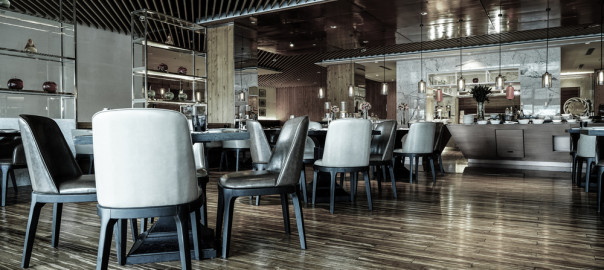
Commercial flooring is a hardy type of flooring designed for constant use. It’s found in offices, shops, restaurants, hospitals, schools, and other busy commercial settings where lots of people walk to and from, so needs to withstand constant pressure.
But what are the types of commercial flooring? In this article, we’ll walk through the range of common durable materials used in commercial spaces, to give you a better understanding of which flooring to choose for your business.
Commercial vinyl flooring
Vinyl is highly durable, easy to install and maintain, and can handle a lot of foot traffic. It’s also one of the cheaper forms of commercial flooring and is a popular option for shops, hospitals, and schools.
Vinyl flooring comes in two types:
Vinyl sheet
Vinyl sheet is a single sheet of vinyl, cut to the shape of the floor. It can create a cohesive and sleek look for a commercial space, and comes in a huge variety of designs and colours. However, as a single piece of material, vinyl sheet is difficult to repair when damaged. It also requires a lot of work to maintain.
Vinyl tiles
Vinyl tiles are squares of vinyl that can be laid down to form a connected pattern. They’re much cheaper to repair when damaged, as the tile can just be replaced.
Commercial laminate flooring
Most people love the look of solid wood flooring, which is why laminate is a popular choice. It looks almost identical to wood but costs a fraction of the price and is much easier to install.
A couple of downsides to laminate flooring: it’s noisy to walk on, which makes it less desirable for places with quieter environments such as offices and libraries, and because of its powdered wood core, it can also be damaged by water more easily.
Commercial hardwood flooring
Hardwood has a look that most people love and is used to create modern, beautiful, and prestigious commercial spaces. It’s durable, easy to clean, and timeless—you won’t need to replace the flooring anytime soon.
On the other hand, hardwood is expensive, so isn’t usually a first choice when it comes to commercial flooring. It also needs to be resealed twice a year, and is loud underfoot.
Commercial carpet flooring
Carpet is one of the most popular choices for commercial offices. It comes in a huge range of prices and designs, and is available in two main types:
Broadloom carpet
Broadloom carpet is a traditional wall-to-wall carpet that comes as single (or few) pieces. It’s usually reserved for homes but is also desirable for commercial spaces due to its softness, quietness, and cozy look.
Common downsides to broadloom include its potentially expensive cost, the time it takes to install (it requires underlay), and its difficulty to repair.
Carpet tiles
As their name suggests, carpet tiles are squares of carpet that are laid out like tiles, connecting to form a cohesive pattern. They tend to be thinner than broadloom carpets and don’t require underlay, which makes them harder underfoot, but also easier to install and simple to replace when damaged. Depending on the pattern of the tiles, you may be able to see the seams in between them.
Commercial concrete flooring
Concrete may not seem the most luxurious of flooring, but modern finishing techniques can create a polished, crisp look that many find desirable. Commercial concrete flooring is highly durable, easy to maintain, and can be mixed with various colours to create awesome designs.
On the downside, concrete feels hard underfoot, is loud to walk across, and when it hasn’t been sealed properly, can be damaged by water. It can also crack due to natural temperature changes.





